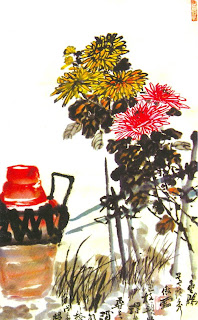Come May 21, it will be the sub-season of Little Fullness, 小 满. This post is to explain what is this sub-season is all about.
From Wikipedia, the free encyclopedia
The traditional East Asian calendars divide a year into 24 solar terms (節氣). Xiǎomǎn (pīnyīn) or Shōman (rōmaji) (Traditional Chinese: 小滿; Simplified Chinese: 小满; Japanese: 小満; Korean: 소만; Vietnamese: Tiểu mãn; literally: "grain full") is the 8th solar term. It begins when the Sun reaches the celestial longitude of 60° and ends when it reaches the longitude of 75°. It more often refers in particular to the day when the Sun is exactly at the celestial longitude of 60°. In the Gregorian calendar, it usually begins around May 21 and ends around June 5 (June 6 East Asia time).
二十四节气大多可以顾名思义,但是小满却有些令人费解。 Most of 24 weather can be just as its name implies, but the Little Fullness is somewhat puzzling. 原来,小满是指麦类等夏熟作物灌浆乳熟,籽粒开始饱满。 In fact, Little Fullness means, such as wheat milky filling summer crops, grain began full. 南方地区的农谚赋予小满以新的寓意:"小满不满,干断思坎";"小满不满,芒种不管"。 Southern region Little Fullness农谚given a new meaning: "Little Fullness dissatisfaction Sircam dry off"; "Little Fullness dissatisfaction regardless of Grain in Ear." 把"满"用来形容雨水的盈缺,指出小满时田里如果蓄不满水,就可能造成田坎干裂,甚至芒种时也无法栽插水稻。 The "full"盈缺used to describe the rain that the fields at Little Fullness if dissatisfied with the water, it may cause cracks田坎, Grain in Ear and even when they can not be planting rice. 因为"立夏小满正栽秧","秧奔小满谷奔秋",小满正是适宜水稻栽插的季节。 Because "Little Fullness is栽秧beginning of summer", "Ben Yeung Ben autumn small Mungo," Little Fullness was suitable for rice planting season. 华南的夏旱严重与否,和水稻栽插面积的多少,有直接的关系;而栽插的迟早,又与水稻单产的高低密切相关。 Severe summer drought in southern China or not, and the number of rice planting area, have a direct relationship; and planting of sooner or later, with the yield of rice is closely related to the high and low. 华南中部和西部,常有冬干春旱,大雨来临又较迟,有些年份要到6月大雨才姗姗而来,最晚甚至可迟至7月。 The central and western South China, often in winter dry spring, and late arrival of heavy rain in some years heavy rain in June to come only slowly, even as late as last July. 加之常年小满节气雨量不多,平均仅40毫米左右,自然降雨量不能满足栽秧需水量,使得水源缺乏的华南中部夏旱更为严重。 Little Fullness annual cycle of rainfall coupled with small, average only about 40 mm, natural rainfall can not meet the water demand栽秧, making water shortage more severe summer drought in central southern China. 俗话说:"蓄水如蓄粮","保水如保粮"。 As the saying goes: "water, such as with food," "water, such as food security." 为了抗御干旱,除了改进耕作栽培措施和加快植树造林外,特别需要注意抓好头年的蓄水保水工作。 In order to resist drought, in addition to measures to improve the farming culture and to accelerate afforestation, special efforts need to pay attention to the first-year water storage work. 但是,也要注意可能出现的连续阴雨天气,对小春作物收晒的影响。 However, we should also pay attention for possible rain, the sun on Koharu the impact of crop land. 西北高原山地区,这时多已进入雨季,作物生长旺盛,欣欣向荣。 Northwest Plateau
Hope you enjoy it, Cheers!











